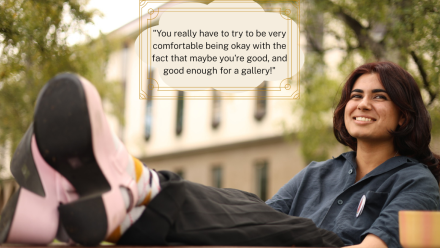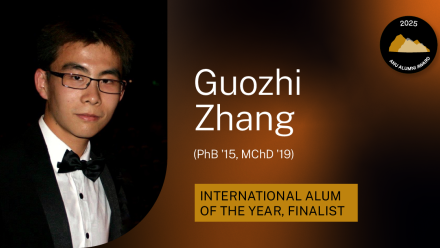ANU Spaces – Carolina Velastegui Paez
Meet Carolina Velastegui Paez ...
Carolina, can you tell us what do you do at the University?
I'm an international student at ANU. I'm from Ecuador, South America and I live in the Galapagos Islands. So here at the University I'm doing a Masters in Museums and Collections.
What is your favourite spot on campus?
I really like the garden near the Fellows Bar. I'm staying at University House in the garden wing.
You like it because...
I feel that that garden is beautiful. It is a nice spot to just sit down and relax and you have all the trees.
If you were free for an afternoon, you would...
I like to go to the movies. Also because of my museum studies I really like to go to exhibitions and to visit all the museums around Canberra. You have a lot of options and good opportunities to learn a lot in exhibitions.
Can you tell us about how you came to be involved in this Crace exhibition?
Before coming here to uni, I read about the field studies and the School of Art. What I really like about the field studies here at uni is they take out the art practice out of the studio and set it in real context so you have the opportunity, asan artist, to engage with communities and with a specific place.
What inspired you to create the works for the exhibition?
What we did in the Crace field study is we visited the place and we had to find an inspiration to begin an art piece. So I found my inspiration at a place called Yurwang Dhaura, that is an Aboriginal site in Crace. It's a heritage site and in the park you can find the material that Aboriginal people use in ceremonies. So I found there my inspiration and actually this piece is called Beings from the Alcheringa Time. Alcheringa is the Aboriginal time where men and nature come to be for the first time. So it's that place where people can still have contact with the spirits that are a part of Aboriginal culture.
Can you describe your artworks to us?
These animals are mythical beings, so what I want to do is make that relation between the dream world and the real world. So the white and black give you that idea that these beings belong to a mythical time. To make the beings, what I did is a mixture between text and drawing. So it's that thin line between writing and speaking. And I use words in Spanish, English and also Aboriginal words that I found at Yurwang Dhaura site. So we began by drawing with the words, which helped bring these beings to life.
What have you learned from the process?
I think one of the most important things about the field study process is that it takes the art practice out of the studio and sets it in a real situation. Also when you go into a field study, one of the main informants about the place is the community. So you have real contact with communities. And I think that makes the art practice more human because you have the opportunity to listen to the others and understand a special place. So I think the bigger scope art field studies are valuable.
In my personal experience also, I came from a practice of collaborative art, community art. And in community art, the final art piece is the process itself. So here I really encounter myself with a final object creation as the final piece. So that was a really good experience for me.
What do you have planned next?
I have one semester more of my Masters degree before I head home back to Galapagos Islands in Ecuador but what I plan to do is apply all of my knowledge that I have gained here at university.
For other prospective students overseas, what would you say to them if they were considering studying at ANU?
I think that this is a very great experience because you grow a lot, being away from home. You learn from a new culture. And as a professional experience it's great as well because you learn a lot. You have the opportunity to meet a lot of professionals. So I think it's a really nice experience personally and professionally. It makes you learn a lot. I would recommend coming to ANU.
Contemplating Crace: First Thoughts runs is at the School of Art Foyer Gallery until 21 June.


